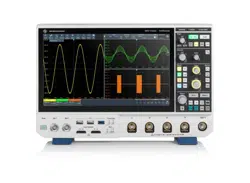Loading ...
Loading ...
Loading ...

Trigger
R&S
®
MXO 4 Series
162User Manual 1335.5337.02 ─ 05
Trigger mode
Sets the trigger mode which determines the behavior of the instrument if no trigger
occurs. The current setting is shown on the trigger label.
To toggle quickly between "Auto" and "Normal" mode, use the [Auto Norm] key on the
front panel (in "Trigger" section).
"Auto"
The instrument triggers repeatedly after a time interval if the trigger
conditions are not fulfilled. If a real trigger occurs, it takes prece-
dence. This mode helps to see the waveform even before the trigger
conditions are set correctly. The waveform on the screen is not
synchronized, and successive waveforms are not triggered at the
same point of the waveform. The time interval depends on the time
base settings.
"Normal"
The instrument acquires a waveform only if a trigger occurs, that is, if
all trigger conditions are fulfilled. If no trigger occurs, no waveform is
acquired and the last acquired waveform is displayed. If no waveform
was captured before, none is displayed.
When no trigger has been found for longer than one second, a mes-
sage box appears that shows the time elapsed since the last trigger.
"Free run"
The instrument starts acquisition immediately and triggers after a
short time interval independent of the time base settings and faster
than in "Auto" mode. Real triggers are ignored. Use this mode if the
"Auto" mode is too slow.
Remote command:
TRIGger:MODE on page 482
Force trigger
Provokes an immediate single acquisition. Force the trigger if the acquisition is running
in normal mode and no valid trigger occurs. Thus, you can confirm that a signal is
available and use the waveform display to determine how to trigger on it.
Remote command:
TRIGger:FORCe on page 482
Holdoff mode
Selects the method to define the holdoff condition.
The trigger holdoff defines when the next trigger after the current will be recognized.
Thus, it affects the next trigger to occur after the current one. Holdoff helps to obtain
stable triggering when the oscilloscope is triggering on undesired events.
Holdoff settings are not available if the trigger source is an external trigger input or
serial bus, and if you trigger on a sequence of events.
Example:
For example, you want to analyze the first pulse in a burst of several pulses. At first,
you select a sufficiently slow time base to display the entire burst. Then, you set the
holdoff time a little longer than the length of the burst. Now, each trigger corresponds to
the first pulse in successive bursts, and you can change the time base to display the
waveform in more detail.
Trigger mode / holdoff
Loading ...
Loading ...
Loading ...
